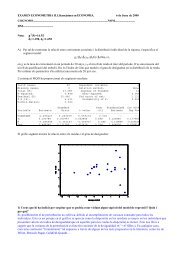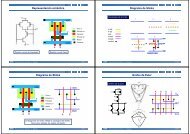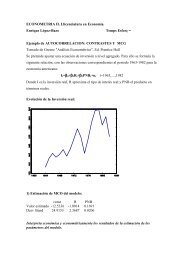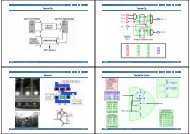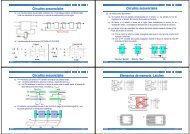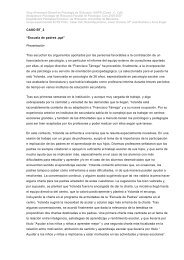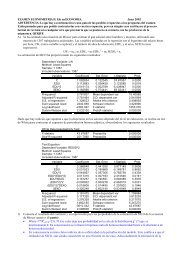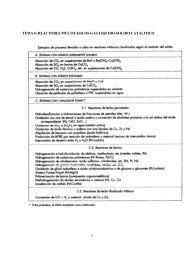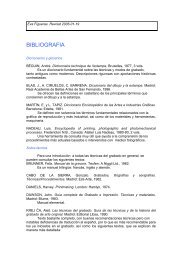Valoración del impuesto sobre la renta.
Valoración del impuesto sobre la renta.
Valoración del impuesto sobre la renta.
Create successful ePaper yourself
Turn your PDF publications into a flip-book with our unique Google optimized e-Paper software.
CAPÍTULO 7. LA IMPOSICIÓN SOBRE LA RENTA<br />
PERSONAL<br />
1. Introducción<br />
2. Estructura <strong>del</strong> <strong>impuesto</strong><br />
2.1. Sujeto pasivo: <strong>la</strong> unidad contribuyente<br />
2.1.1. Criterios de elección<br />
2.1.2. Tributación familiar<br />
2.1.2.1. Mecanismos para paliar o evitar el efecto de <strong>la</strong><br />
progresividad en <strong>la</strong> acumu<strong>la</strong>ción de <strong>renta</strong>s<br />
2.1.3. Tributación individual<br />
2.2. Base imponible<br />
2.2.1. Definición de <strong>renta</strong><br />
2.2.1.1. Definición económica: Haig-Simons<br />
2.2.1.2. Definición legal<br />
2.2.2. Imposición analítica frente a imposición sintética<br />
2.2.3. Las ganancias de capital<br />
2.2.3.1. Concepto y c<strong>la</strong>ses<br />
2.2.3.2. Problemática en torno a su tratamiento fiscal<br />
2.2.3.3. Formas de gravamen<br />
2.2.4. El periodo impositivo y <strong>la</strong>s <strong>renta</strong>s irregu<strong>la</strong>res<br />
2.3. Tipos impositivos
3. El impacto de <strong>la</strong> inf<strong>la</strong>ción<br />
4. <strong>Valoración</strong> económica <strong>del</strong> <strong>impuesto</strong><br />
4.1. Eficiencia<br />
4.1.1. Oferta de trabajo<br />
4.1.2. Ahorro<br />
4.1.2.1. Nivel de ahorro<br />
4.1.2.2. Composición <strong>del</strong> ahorro<br />
4.2. Equidad<br />
4.2.1. La progresividad y factores que inciden <strong>sobre</strong> el<strong>la</strong><br />
4.3. Sencillez<br />
4.4. Flexibilidad<br />
5. Propuestas alternativas a <strong>la</strong> imposición personal<br />
5.1. Propuestas alternativas<br />
5.1.1. El <strong>impuesto</strong> lineal <strong>sobre</strong> <strong>la</strong> <strong>renta</strong><br />
5.1.2. El <strong>impuesto</strong> negativo <strong>sobre</strong> <strong>la</strong> <strong>renta</strong><br />
5.1.3. El <strong>impuesto</strong> dual nórdico<br />
5.1.4. El <strong>impuesto</strong> <strong>sobre</strong> el gasto personal<br />
2
2 ESTRUCTURA<br />
2.1 Sujeto pasivo – unidad contribuyente<br />
⇒ Tributación familiar o conjunta<br />
⇒ Tributación individual o separada<br />
2.1.1. Criterios selección<br />
1. Las familias con los mismos ingresos deben pagar los mismos<br />
<strong>impuesto</strong>s.<br />
2. Las personas que viven juntas y comparten gastos tienen una<br />
capacidad de pago mayor que si vivieran so<strong>la</strong>s.<br />
3. Los trasvases de <strong>renta</strong> entre miembros de una familia no deben<br />
utilizarse para pagar menos <strong>impuesto</strong>s.<br />
4. El tipo impositivo marginal que soporta cada miembro de una<br />
familia no debe verse afectado por <strong>la</strong>s <strong>renta</strong>s que perciben los demás<br />
miembros de <strong>la</strong> misma.<br />
5. La elección de <strong>la</strong> unidad contribuyente no debería incidir <strong>sobre</strong> el<br />
estado civil de los contribuyentes.<br />
3
Esquema 1. Mecanismos para paliar el efecto de <strong>la</strong> progresividad en <strong>la</strong><br />
acumu<strong>la</strong>ción de <strong>renta</strong>s<br />
1- Mecanismos de promediación de <strong>la</strong> base<br />
a) Sistema de partición o splitting<br />
R1<br />
+ R2<br />
BI =<br />
2<br />
primera<br />
C = BI ×<br />
= × 2<br />
primera<br />
final C C<br />
b) Sistema <strong>del</strong> cociente o quotient<br />
R<br />
BI =<br />
i<br />
1<br />
primera<br />
C = BI × t<br />
C<br />
final<br />
= C<br />
primera<br />
i<br />
t<br />
i<br />
× i<br />
2- Aplicación de tarifa impositiva diferente<br />
3- Sistema de deducciones en <strong>la</strong> base o en <strong>la</strong> cuota<br />
4- Sistema de agregación parcial<br />
5- Sistema de exclusión de <strong>la</strong> <strong>renta</strong> <strong>del</strong> segundo perceptor<br />
4
Esquema 2. Definición de <strong>renta</strong> económica (Yi) de Haig-Simons<br />
Yi = Ci ± ∆Wi<br />
• Consumo (Ci) = Bienes y servicios adquiridosi<br />
Autoconsumoi<br />
Retribuciones en especiei<br />
Servicios derivados de <strong>la</strong> utilización de bienes<br />
duraderosi<br />
• Variación en <strong>la</strong> riqueza (∆Wi) = Ahorroi<br />
Bienes adquiridos gratuitamentei<br />
Ganancias de capitali<br />
5
Cuadro 1. El diferimiento de <strong>impuesto</strong>s: ganancias de capital no<br />
realizadas<br />
Año Valor final<br />
1 100.000 x (1,05) = 105.000<br />
2 105.000 x (1,05) = 100.000 x (1,05) 2 =<br />
3 110.250 x (1,05) = 100.000 x (1,05) 3 =<br />
6<br />
110.250<br />
115.763<br />
4 115.763 x (1,05) = 100.000 x (1,05) 4 = 121.551<br />
5 121.551 x (1,05) = 100.000 x (1,05) 5 = 127.628<br />
Plusvalía = 27.628 euros.<br />
Tipo impositivo 15% ⇒ cuota 4.144 euros<br />
Ganancia neta después <strong>del</strong> <strong>impuesto</strong>: 23.484 euros<br />
Año Valor final<br />
1<br />
2<br />
3<br />
4<br />
5<br />
100.000 x (1,05) =<br />
105.000<br />
104.250 x (1,05) =<br />
109.463<br />
108.681 x (1,05) =<br />
114.115<br />
113.300 x (1,05) =<br />
118.965<br />
118.115 x (1,05) =<br />
124.021<br />
Ganancia<br />
bruta<br />
periodo<br />
Ganancia neta después <strong>del</strong> <strong>impuesto</strong>: 23.135 euros<br />
Diferencia = 349 euros<br />
Impuesto<br />
(15%)<br />
Ganancia<br />
neta<br />
periodo<br />
5.000 750 4.250<br />
5.213 782 8.681<br />
5.434 815 13.300<br />
5.665 850 18.115<br />
5.906 886 23.135
EFECTOS DE LAS RENTAS IRREGULARES (EXCESO<br />
TRIBUTACIÓN)<br />
1- La existencia de un mínimo exento y otras deducciones<br />
Supóngase que Óscar y Enrique obtienen <strong>la</strong>s siguientes <strong>renta</strong>s durante<br />
dos periodos impositivos y que el mínimo exento es de 500:<br />
Periodo Óscar Enrique<br />
1 500 400<br />
2 500 600<br />
Total 1.000 1.000<br />
2 - La aplicación de tarifas progresivas:<br />
Supóngase ahora que Juan y Pedro obtienen <strong>la</strong>s siguientes <strong>renta</strong>s durante<br />
dos periodos impositivos:<br />
Periodo Juan Pedro<br />
1 700 400<br />
2 700 1.000<br />
Total 1.400 1.400<br />
La normativa <strong>del</strong> <strong>impuesto</strong> <strong>sobre</strong> <strong>la</strong> <strong>renta</strong> establece para los dos periodos<br />
<strong>la</strong> misma tarifa progresiva por tramos:<br />
Tramo de <strong>renta</strong><br />
Tipo<br />
impositivo<br />
0 – 800 10%<br />
> 800 20%<br />
Por tanto, <strong>la</strong> cuota resultante será <strong>la</strong> siguiente:<br />
Periodo Juan Pedro<br />
1 70 40<br />
2 70 120<br />
Total 140 160<br />
7
Esquema 3. Problemática y tratamiento de <strong>la</strong>s <strong>renta</strong>s irregu<strong>la</strong>res<br />
Discriminación de <strong>la</strong>s <strong>renta</strong>s irregu<strong>la</strong>res:<br />
a) Existencia de un mínimo exento y de otras deducciones<br />
b) Aplicación de tarifas progresivas<br />
Tratamientos posibles:<br />
a) Sistema de anualización<br />
b) Sistema de medias móviles<br />
c) Sistema de reducción<br />
8
Tarifa impositiva base general IRPF español. Año 2006<br />
(Suma tipo estatal y tipo autonómico)<br />
BASE LIQUIDABLE TIPO MARGINAL<br />
0,00 - 4.161,60 15%<br />
4.161,61 - 14.357,52 24%<br />
14.357,53- 26.842,32 28%<br />
26.842,33 - 46.818,00 37%<br />
> 46.818,00 45%<br />
Año 2007<br />
(Suma tipo estatal y tipo autonómico)<br />
BASE LIQUIDABLE TIPO MARGINAL<br />
0,00 – 17.360 24%<br />
17.360- 32.360 28%<br />
32.360- 52.360 37%<br />
> 52.360 43%<br />
Esquema 4. Factores que inciden <strong>sobre</strong> <strong>la</strong> progresividad <strong>del</strong> <strong>impuesto</strong><br />
• Mínimo exento<br />
• Deducciones específicas en <strong>la</strong><br />
base o en <strong>la</strong> cuota<br />
• Estructura tarifaria<br />
• Otros factores<br />
9<br />
Progresividad<br />
formal<br />
Progresividad<br />
real
Gráfico 1. Impuesto lineal: tipo medio y tipo marginal<br />
TIPO IMPOSITIVO<br />
Tipo medio<br />
RENTA<br />
10<br />
Tipo marginal
Esquema 5. Alternativas a <strong>la</strong> imposición personal<br />
• Impuesto lineal <strong>sobre</strong> <strong>la</strong> <strong>renta</strong>: tipo único proporcional <strong>sobre</strong> <strong>la</strong> <strong>renta</strong> que<br />
supere el mínimo exento<br />
• Impuesto negativo <strong>sobre</strong> <strong>la</strong> <strong>renta</strong>: <strong>renta</strong> mínima garantizada a todos los<br />
individuos<br />
• Impuesto dual nórdico: tipo proporcional reducido <strong>sobre</strong> <strong>la</strong>s <strong>renta</strong>s <strong>del</strong><br />
capital<br />
• Impuesto <strong>sobre</strong> el gasto personal: gravamen directo <strong>del</strong> consumo de un<br />
individuo<br />
11



